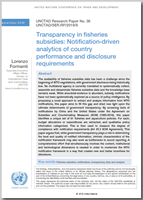
The availability of fisheries subsidies data has been a challenge since the beginning of WTO negotiations, with government disclosure being historically low. No multilateral agency is currently mandated to systematically collect, assemble and disseminate fisheries subsidies data and the knowledge base remains weak. While anecdotal evidence is abundant, subsidy notifications have not been systematically explored as a source of policy intelligence.
By proposing a novel approach to extract and analyze information from WTO notifications, this paper aims to fill this gap and shed new light upon the ultimate determinants of government transparency. By screening texts of notifications by China and the United States under the Agreement on Subsidies and Countervailing Measures (SCM) (1995-2016), this paper identifies a unique set of 61 fisheries and aquaculture policies. For each, budget allocations or expenditures are extracted, and qualitative policy information categorized. This is then used to measure the degree of compliance with notification requirements (Art 25.3 SCM Agreement).
This paper argues that, while government transparency plays a role in determining the level and quality of notified information, intrinsic characteristics of the notification framework may also work as bottlenecks to sound reporting. A comprehensive effort that simultaneously involves the content, institutional and technological dimensions is needed in order to modernize the WTO notification framework in a way that creates new and better incentives for disclosure.
The objective of this paper is to explore the viability of WTO notifications as a source of subsidy information. By extracting and analyzing data and information from WTO notifications, this research provides new insight into government transparency, e.g. the degree of compliance with notification obligations, and assess the effectiveness of notification mechanisms, rules and obligations under the WTO Agreement on Subsidies and Countervailing Measures (SCM).
The analysis is performed on a unique set of 61 fisheries and aquaculture policies, identified by screening notification texts by China and the United States from inception until the last notification cycle (2017). For each, subsidy amounts, i.e. budget allocations or expenditures in domestic currency, were extracted and qualitative policy information categorized. This resulted in the compilation of a first-of-its-kind database, including time series of subsidy amounts.
Section 1 provides theoretical background and reviews the most authoritative literature on the topic.
Section 2 describes the methodology underpinning this work, with a focus on data collection.
Section 3 presents the methods and results of the analysis. In particular, compliance of notification content with SCM requirements is assessed against equally weighted criteria, developing binary indicators of country performance (sub-section 3.1). The values of subsidies notified to the WTO and the OECD are compared and contrasted, with a view to detect trends in policy disclosure (sub-section 3.2). An in-depth assessment of the WTO notification framework is also provided in an effort to identify content-related, technological and institutional shortcomings, i.e. bottlenecks to better reporting (sub-section 3.2).
Section 4 summarizes research findings and develop accordingly some policy recommendations.


